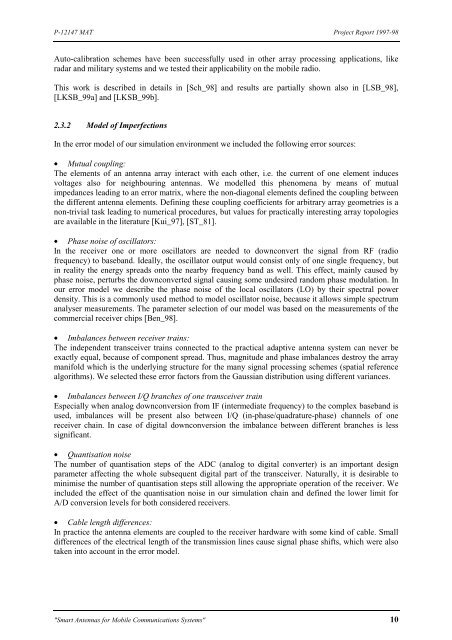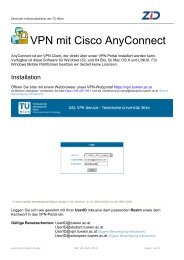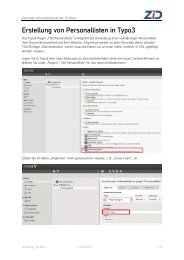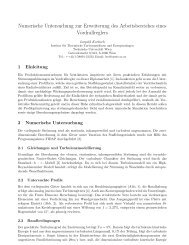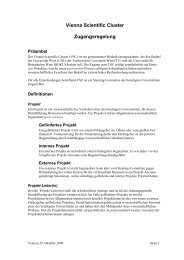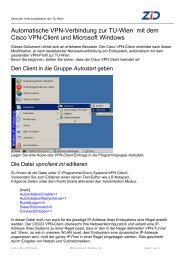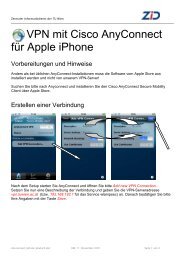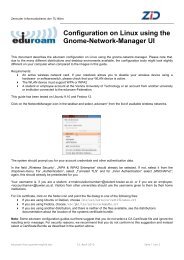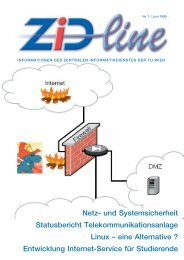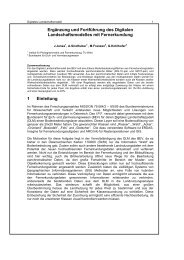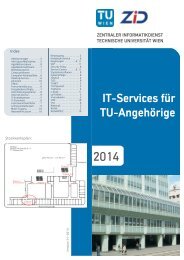Smart Antennas for Mobile Communication Systems - ZID ...
Smart Antennas for Mobile Communication Systems - ZID ...
Smart Antennas for Mobile Communication Systems - ZID ...
Create successful ePaper yourself
Turn your PDF publications into a flip-book with our unique Google optimized e-Paper software.
P-12147 MAT Project Report 1997-98<br />
Auto-calibration schemes have been successfully used in other array processing applications, like<br />
radar and military systems and we tested their applicability on the mobile radio.<br />
This work is described in details in [Sch_98] and results are partially shown also in [LSB_98],<br />
[LKSB_99a] and [LKSB_99b].<br />
2.3.2 Model of Imperfections<br />
In the error model of our simulation environment we included the following error sources:<br />
• Mutual coupling:<br />
The elements of an antenna array interact with each other, i.e. the current of one element induces<br />
voltages also <strong>for</strong> neighbouring antennas. We modelled this phenomena by means of mutual<br />
impedances leading to an error matrix, where the non-diagonal elements defined the coupling between<br />
the different antenna elements. Defining these coupling coefficients <strong>for</strong> arbitrary array geometries is a<br />
non-trivial task leading to numerical procedures, but values <strong>for</strong> practically interesting array topologies<br />
are available in the literature [Kui_97], [ST_81].<br />
• Phase noise of oscillators:<br />
In the receiver one or more oscillators are needed to downconvert the signal from RF (radio<br />
frequency) to baseband. Ideally, the oscillator output would consist only of one single frequency, but<br />
in reality the energy spreads onto the nearby frequency band as well. This effect, mainly caused by<br />
phase noise, perturbs the downconverted signal causing some undesired random phase modulation. In<br />
our error model we describe the phase noise of the local oscillators (LO) by their spectral power<br />
density. This is a commonly used method to model oscillator noise, because it allows simple spectrum<br />
analyser measurements. The parameter selection of our model was based on the measurements of the<br />
commercial receiver chips [Ben_98].<br />
• Imbalances between receiver trains:<br />
The independent transceiver trains connected to the practical adaptive antenna system can never be<br />
exactly equal, because of component spread. Thus, magnitude and phase imbalances destroy the array<br />
manifold which is the underlying structure <strong>for</strong> the many signal processing schemes (spatial reference<br />
algorithms). We selected these error factors from the Gaussian distribution using different variances.<br />
• Imbalances between I/Q branches of one transceiver train<br />
Especially when analog downconversion from IF (intermediate frequency) to the complex baseband is<br />
used, imbalances will be present also between I/Q (in-phase/quadrature-phase) channels of one<br />
receiver chain. In case of digital downconversion the imbalance between different branches is less<br />
significant.<br />
• Quantisation noise<br />
The number of quantisation steps of the ADC (analog to digital converter) is an important design<br />
parameter affecting the whole subsequent digital part of the transceiver. Naturally, it is desirable to<br />
minimise the number of quantisation steps still allowing the appropriate operation of the receiver. We<br />
included the effect of the quantisation noise in our simulation chain and defined the lower limit <strong>for</strong><br />
A/D conversion levels <strong>for</strong> both considered receivers.<br />
• Cable length differences:<br />
In practice the antenna elements are coupled to the receiver hardware with some kind of cable. Small<br />
differences of the electrical length of the transmission lines cause signal phase shifts, which were also<br />
taken into account in the error model.<br />
"<strong>Smart</strong> <strong>Antennas</strong> <strong>for</strong> <strong>Mobile</strong> <strong>Communication</strong>s <strong>Systems</strong>" 10


